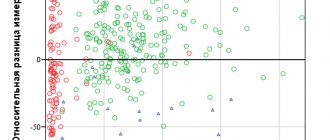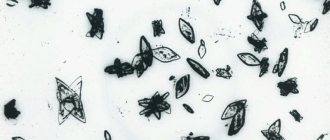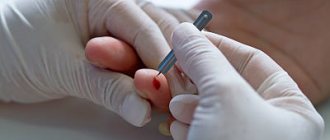- How and on what days of the cycle should women take a testosterone test?
- How to reduce testosterone?
- Attending doctors
- Prices for services
Testosterone is considered a male hormone, but in women it is also produced, although in much smaller quantities, in the ovaries and adrenal glands.
The effect of testosterone on a woman's body
The role of testosterone in the female body is quite diverse: this hormone is responsible for the normal development of the skeleton, the ratio of fat and muscle tissue, the production of gonadotropins and the development of follicles in the ovaries. In addition, testosterone determines sexual desire (libido) in both sexes.
Normally, the level of testosterone in the female body is not always the same. Its physiological increase is characteristic of the period of ovulation and the third trimester of pregnancy. In later stages, the hormone level can be almost 3 times higher than normal. It is also characteristic that testosterone levels increase with age, that is, during the premenopausal period its highest concentration is observed.
Both a decrease and an increase in testosterone levels indicate various disorders in the body.
Content standards
Throughout life, a person’s testosterone levels change. For example, in boys, the level of this hormone increases as they grow older, peaking during puberty (puberty). With age, men experience a decrease in androgen levels. The minimum hormone content is determined in the evening, the maximum in the morning. For this reason, it is recommended to donate blood for SHBG in the first half of the day.
In women, testosterone levels fluctuate throughout the cycle. So, if the SHBG hormone is elevated during ovulation, then this is normal.
During pregnancy, testosterone levels also increase. It is reduced in postmenopausal women.
The general standard is:
- women of reproductive age – 0.45 – 3.75 nmol/l.
- men from 14 to 55 years old – 5.76 – 28.14 nmol/l.
However, only a doctor can correctly decipher the obtained research result and explain what the analysis shows, taking into account other examinations and individual factors. After this, treatment is prescribed and it is determined when to take a repeat test.
Increased testosterone in women - what are the reasons?
An increase in testosterone levels in women can be due to various reasons:
- Dysfunction of the adrenal cortex, which causes the production of the hormone in large quantities
- Pituitary dysfunction
- Volumetric formations
- PCOS, ovarian dysfunction
- Volumetric formations
- Genetic factor
In addition, an increase in testosterone levels can be caused by poor nutrition, as well as taking hormonal medications.
Indications for use
In women, the diagnostic component: - hyperandrogenism, as a cause of ovulatory dysfunction, infertility, miscarriage, - PCOS, - non-classical form of congenital adrenal hyperplasia, - stromal ovarian hyperthecosis, - hyperandrogenic dermatopathies: alopecia, acne, oily seborrhea and hirsutism, - hormone - producing tumors of the ovaries and adrenal glands - monitoring of antiandrogen therapy. In men: - component of the diagnosis of hypogonadism, infertility, erectile dysfunction, decreased libido, hormone-producing tumors of the gonads and adrenal glands, - monitoring of androgen replacement and antiandrogen therapy. In boys: - component of the diagnosis of premature puberty, delayed puberty.
Symptoms of high testosterone in women
An increased content of male hormones in the female body is called hyperandrogenism and has a number of characteristic symptoms.
- Male pattern hair growth with predominant hair distribution on the face, abdomen and chest (hirsutism). This is perhaps the most obvious external sign of excessive testosterone production in the female body.
- Increased oiliness of the skin, blockage of the sebaceous glands, which leads to acne
- Virilization: increase in the size of the clitoris, androgen-dependent alopecia, narrowing of the pelvis along with the development of the shoulder girdle, involution of the mammary glands
- Menstrual irregularities up to complete cessation of menstrual bleeding (amenorrhea)
- Lack of ovulation in the menstrual cycle
It is important to remember that elevated testosterone levels increase the risk of miscarriage and premature birth in pregnant women.
How to get tested
To conduct the study, a blood sample is taken from a vein. Determining the most informative result occurs when a person is properly prepared for analysis. It is recommended that women undergo analysis on days 6-8 of the cycle. For both genders:
- fasting blood sampling;
- refrain from taking medications and alcohol for two to three days;
- stop smoking one hour before;
- be in a calm state.
If you contact the INVITRO laboratory, you will find out what testosterone is responsible for in your body, how to raise or lower its level. The blood sampling procedure is carried out by qualified specialists using a disposable instrument. The equipment here is the best, allowing you to get accurate results.
Determination of testosterone levels (free testosterone index)
After testosterone is formed in the adrenal glands or ovaries of a woman, most of it combines with blood proteins and becomes biologically inactive, that is, unable to bind to receptors. This is the so-called bound fraction of testosterone. The remaining approximately 2% is free testosterone, which in tissues that have receptors for this hormone is converted into an active form and causes a specific metabolic reaction in target organs. It is free testosterone that determines the characteristic manifestations of hyperandrogenism. Total testosterone level = free fraction + bound fraction.
It must be borne in mind that as the concentration of estrogen in the body increases, the level of free testosterone decreases. And, accordingly, with a decrease in estrogen levels, free testosterone increases. In this regard, it is advisable to determine the level of both total and free testosterone.
Total testosterone and free testosterone
Testosterone is a hormone that should be capitalized because it is what allows a man to remain a man, although its action is not limited to the reproductive system. It creates libido, maintains erection, improves sperm quality and has a positive effect on every cell of the male body. Many doctors call it “gasoline” for a man - it is Testosterone that is responsible for a person’s ambitions and his activity.
Most of the Testosterone is produced in the testicles and travels with the blood to all organs and systems. The highest level of hormones is observed until the age of 27-30, then a systematic decline occurs. As soon as the concentration of Testosterone decreases, a decrease in sexual activity and muscle mass, a gain in fat weight, and a series of somatic diseases may occur. Hormonal deficiency can be observed after 30 years.
A critical disruption of Testosterone production occurs when the testicles are damaged or absent - yes, such situations exist.
Testosterone works in several derivative forms in combination with other hormonal elements, so it is important to understand hormonal balance - the first place is SHBG - sex hormone binding hormone - this is a protein that creates a connection with Testosterone and reduces its productive work - this happens taking into account the protein - Albumin. So, Testosterone entered the blood, part of it bound to proteins, the rest began to work in the cells - “working” Testosterone and is called “Free”. Those. There can be a lot of hormone, but most of it is associated with proteins - the working component is low. If Testosterone is low, but there is also little protein, then it can perfectly perform its functions without any worries on the part of the man.
Free Testosterone is a unit of account and if data on total Testosterone and proteins is available, it can be found out.
It is worthwhile to determine these indicators if there is a violation of the functionality of the reproductive system, decreased activity and libido, lack of morning erections, weight gain, fatigue, weakness, and decreased performance.
It is not difficult to diagnose hormonal disorders - just donate blood for testing in the morning and after a couple of days discuss the final result with a urologist, based on the results a plan will be drawn up to correct the disorders.
At International Medical, you can undergo diagnosis and treatment from qualified urologists and andrologists and solve the problem. Book your consultation today.
Author of the article: Cherepanov Denis Anatolyevich Urologist-andrologist
How to reduce testosterone levels in women?
Since the reasons for increased androgen levels in women can be different, a thorough examination is required first. If you experience the symptoms described above, you should immediately contact a specialist. Treatment of infertility caused by increased testosterone levels requires an individual approach to each case.
To normalize testosterone levels, therapeutic diets, surgery (in the presence of tumors), and hormonal therapy can be used.
If you have any questions related to increasing testosterone, you can ask them to the doctors at Nova Clinic. You can make an appointment with a doctor by calling the number listed on the website or using the booking button.
What diseases cause an increase in the level of free testosterone in the blood?
The level of free testosterone increases in men with hormone-producing tumors of the adrenal glands and testicles, early puberty, and androgynous insensitivity (resistance) syndrome; in women – with polycystic ovary syndrome (PCOS), hirsutism (excessive male pattern hair growth), tumors of the adrenal glands, ovaries or endometrium (inner layer of the uterus); in persons of both sexes - with adrenal hyperplasia, Itsenko-Cushing syndrome and disease.
The level of free testosterone decreases in men with hypogonadism (insufficient testicular function - can be either congenital or acquired, for example, due to injury, viral infection, exposure to ionizing radiation, etc.), erectile dysfunction, Alzheimer's disease, and some genetic diseases ( Klinefelter's syndrome - polysomy XXY, etc.), etc.
Why might the analysis result be incorrect?
The concentration of free testosterone can be affected by intense physical activity, psycho-emotional factors, drinking alcohol the day before the test and smoking half an hour before the test.
Drugs can affect the level of free testosterone, both increasing it and decreasing it. Therefore, before taking the test, it is necessary to tell your doctor about all the medications and supplements you are receiving - perhaps he will adjust the dose or regimen, and will also be able to interpret the test result taking this information into account.
The concentration of testosterone in the blood in men changes during the day, in women - on different days of the cycle.
Detection limits: 0.04-100.0 pg/ml.
Androgens, hyperandrogenism, hirsutism
Hyperandrogenism? Hirsutism? Increased content of “male” sex hormones? Infertility? Anovulation? Polycystic ovary syndrome?
Hyperandrogenism? Hirsutism? Increased content of “male” sex hormones? Infertility? Anovulation? Polycystic ovary syndrome?
Our laboratory performs extensive androgen testing.
TWO ANALYSIS BLOCKS
Free androgen index. Calculation of free and bioavailable testosterone: screening for androgens in a general hormonal examination.
Androgen profile: complete examination for androgens in the presence of hyperandrogenism, hirsutism, infertility, anovulation, PCOS, menstrual irregularities.
In addition to the main indicators performed within the block, the result indicates several calculated indicators, including free and bioavailable testosterone.
Read about the composition of the blocks, cost, delivery conditions, and completion dates here:
- Free androgen index. Calculation of free and bioavailable testosterone.
- Androgen profile
Section Contents
- Why is a test for total testosterone not enough?
- When to take tests
- Comprehensive examination for polycystic ovary syndrome, hyperandrogenism, hirsutism, cycle disorders
- Dictionary
Why is a test for total testosterone not enough?
Typically, total testosterone is measured to assess androgen status.
Total testosterone is presented in two fractions:
A small part of testosterone circulates in the blood in a free state (not bound to any proteins). This testosterone is called free. It can have biological effects on the body's cells.
Another part of testosterone is bound to proteins :
- strong binding to sex hormone binding protein (SHBG). This part of testosterone is inactive.
- The other part, weakly and reversibly associated with another protein - albumin - just like free testosterone, is an active participant in regulation.
Thus, free testosterone and testosterone bound to albumin can enter the target cells and constitute bioavailable testosterone.
Bioavailable testosterone = free testosterone + albumin-bound testosterone
Thus, the content of testosterone fractions depends on both testosterone levels and protein content. We see that the conventional test for total testosterone does not reflect the true effect of the hormone on target cells. Only analysis with the determination of indices can provide the most accurate information.
In our laboratory, the study of the level of individual indicators is carried out using modern automatic equipment, and calculations are carried out using special computer software.
When to take the tests:
Androgen status is assessed on days 7-10 of the menstrual cycle
Comprehensive examination for polycystic ovary syndrome, hyperandrogenism, hirsutism, cycle disorders
Question: I have cycle disorders, sometimes there are delays in menstruation, and there is an increase in hair growth on my body. How serious is this and what can be done about it?
Those signs that concern you may be a consequence of the existing characteristics of the body’s hormonal regulation, and may be associated with a change in the ratio between various ovarian hormones, as well as with changes in the level of adrenal hormones.
This can cause both excess hair growth and menstrual irregularities. In many cases, these seemingly harmless problems can hide trends that can affect overall health.
Ovulation disturbance may partly occur against a background that predisposes to the development of metabolic disorders (overweight, increased risk of diabetes), as well as hyperplastic processes in the uterine mucosa - endometrium, diseases of the mammary glands, which increases the risk of oncological pathology from the endometrium and mammary glands.
Therefore, these disorders may be accompanied by an increase in risk for overall health and lead to a decrease in life expectancy. These changes can accumulate over many years and even decades in a woman’s body, so timely, correct and high-quality diagnosis of such conditions is important.
Menstrual irregularities and excess body hair growth can be a consequence of so-called hyperandrogenic conditions, that is, conditions that are accompanied by an increase in the level of hormones traditionally called male. This concept is not entirely correct, since these hormones are always present in a woman’s body and perform very important functions. Problems arise when there is an abnormal ratio between these hormones and those that the ovary should produce in large quantities (estrogens in the first phase of the cycle, estrogens and progesterone in the second, after ovulation).
In order to correctly diagnose possible disorders, a correct and comprehensive diagnosis is necessary, prescribed by a medical specialist, which includes hormonal, biochemical tests, ultrasound and functional diagnostics.
In the early follicular phase (before the selection of the dominant follicle), the level of hormones that control the functioning of the ovaries (LH, FSH, prolactin) is determined.
After the 5th day of the cycle, most women experience the release of a so-called dominant follicle, that is, a formation inside the ovary that has powerful secretion. An egg matures inside it, which can participate in fertilization. The function of the dominant follicle is determined using special tests, where the first place is given to hormonal examination. At the same time, the level of the main female hormone – estradiol is measured, and a comprehensive determination of the level of “male” hormones and their transport proteins is carried out with the calculation of a number of indicators. At CIR Laboratories LLC, this examination is called “Androgen profile”. Unlike the usual determination of the level of total testosterone, the androgen profile includes the determination of indicators such as androstenedione, androstanediol glucuronide, which make it possible to more accurately determine the degree of impairment and the risks of complications. In hyperandrogenic conditions, ovulation may be disrupted, which is dangerous due to the development of hyperplastic processes. To determine ovulation, the level of corpus luteum hormones (estradiol, progesterone) is determined.
When the level of androgens in a woman’s body increases, the endocrine function of the pancreas is often involved. A condition called insulin resistance is accompanied by direct stimulation of testosterone production under the influence of excess amounts of insulin (a pancreatic hormone), which further leads to impaired ovulation and the development of metabolic disorders. To clarify the metabolic status and the possible role of insulin resistance, a complex analysis is carried out, which is called “Metabolic block” at CIR Laboratories LLC. In this case, several biochemical indicators are determined on an empty stomach, as well as indicators 1 and 2 hours after the sugar load.
In many cases, a special molecular genetic study is indicated, which allows us to identify hidden hereditary risks of hyperandrogenism and metabolic disorders. Such a comprehensive examination allows you to make a diagnosis and prescribe optimal treatment. These conditions can be corrected with the help of medications, recommendations for nutrition, regimen and sports.
Dictionary
Hyperandrogenism is a condition characterized by increased production of androgens.
Hirsutism is excess male pattern hair growth in women.
Anovulation is the absence of ovulation.
Hormones are chemical substances that are secreted by endocrine glands into the blood and affect various organs and target tissues.
Androgens are steroid hormones that are produced by the sex glands (in men - the testes, in women - the ovaries) and the adrenal cortex and affect many body systems (anabolic effect, development of male sexual characteristics, psychosexual effects, etc.). Androgens: testosterone, androstenedione, androstanediol glucuronide, DEA-S, etc.
Other steroid hormones are corticosteroids (for example, cortisol), estrogens (estrone, estradiol, estriol, etc.).






